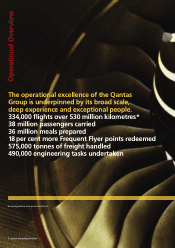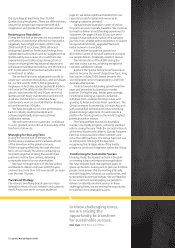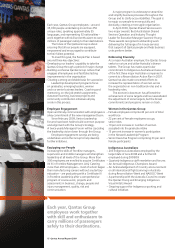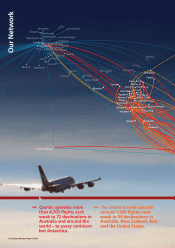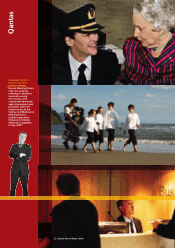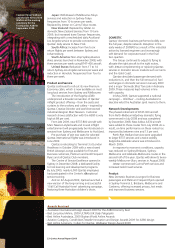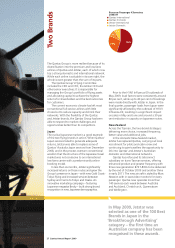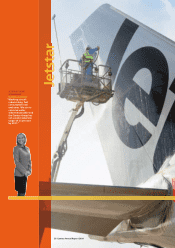Qantas 2009 Annual Report Download - page 20
Download and view the complete annual report
Please find page 20 of the 2009 Qantas annual report below. You can navigate through the pages in the report by either clicking on the pages listed below, or by using the keyword search tool below to find specific information within the annual report.
Our Fleet
At 30 June 2009, the Qantas Group operated a
fleet of 229 passenger aircraft and four dedicated
freighter aircraft. The Group also wet-leases
(including crew) three B747-400 and one
B767-200 freighter aircraft.
During the year, Qantas took delivery of three
Airbus A380s, two A330-200s, three Boeing 737-
800s and five Bombardier Q400s. Jetstar took
delivery of five A320-200s and two A321-200s.
The Group retired four B747-300s, two B737-
300s, six Dash 8-100s and three B717-200s.
Between 30 June and 31 October 2009, a further
two A380s, one A321-200, three B737-800s and
four Q400s are being added to the fleet.
Strategy
For the Qantas Group, fleet planning is about
balancing the immediate flying needs of the
business while investing in new aircraft to drive
long term improvements in safety, passenger
comfort, cost, fuel efficiency, noise emissions,
freight capacity and range capability.
More than 160 new aircraft are planned for
delivery over the next 10 years as part of the
Group’s fleet renewal program. As these come
online, older aircraft and some aircraft types will
be phased out.
The new generation A380 and the B787
Dreamliner remain central to the future of the
Group’s flying businesses. Both types were
carefully assessed to ensure they matched specific
safety, performance, market and route
requirements. For flying needs outside the scope
of these two aircraft types, the Qantas Group will
continue to monitor manufacturers’
developments, as well as the suitability and
balance of its order book, to manage the
changing needs of its network.
The A380 will replace B747s on mature dense
routes such as London and Los Angeles and the
A380 fleet will grow to 20 over the next six years.
The B787 will be ideal for point-to-point flying
on medium density routes, both short and long
haul; facilitating Jetstar’s growth into Europe and
in Asia; operating Qantas services into Asia; and
potentially operating high traffic routes on the
Qantas domestic network. The arrival of this new
aircraft type will allow for the retirement of
Qantas’ B767 fleet. The expected range of the
B787s means that Qantas and Jetstar can fly more
point-to-point services without the need to
operate via hubs, a key advantage for ‘end of the
line’ carriers.
In 2008/09, a deterioration in passenger
demand underpinned decisions to reduce flying,
and in some cases retire, older aircraft. In April
2009, Qantas announced it would ground and
reduce the utilisation of the equivalent of 10
aircraft (B747s and B767s) and make eight
available for sale. The firm aircraft order delivery
stream has also been reviewed and, through
discussions with manufacturers, some aircraft
have been cancelled or deferred. Fifteen B787-9
orders have been cancelled, with the total B787
firm order reduced from 65 to 50 – the second
largest airline order in the world for this aircraft
type. Four A380s, 12 B737-800s and 15 B787-8s
have been deferred. The first B787 should now
arrive in mid-2013 and the early deliveries are
expected to operate on Jetstar’s international
network.
The cornerstone of QantasLink’s fleet renewal
remains the 72-seat turbo-prop Bombardier
Q400. QantasLink now operates 14 Q400s, which
enabled the retirement of the Dash 8-100 fleet by
December 2008 and increased capacity on key
regional routes. QantasLink’s Q400 fleet will grow
to 21 by February 2010.
In line with its short haul fleet plan announced
in 2007, the Group is acquiring 92 narrow-body
aircraft to support Qantas and Jetstar domestic
and short haul international growth. Over the six
years to 2015, 61 A320/A321 aircraft and 31
B737-800s are to be delivered, with options
and purchase rights allowing flexibility for an
additional 89 aircraft.
A Sustainable Airline Group
The fuel efficiency and lower emissions
technology of newer aircraft will contribute
significantly to the cost and environmental savings
required for the Qantas Group’s long term
sustainability. The A380 burns around 10 per cent
less fuel per passenger and emits substantially less
noise than the B747, which it will largely replace.
The B787 will offer a greater than 20 per cent
reduction in fuel consumption per passenger and
a 50 per cent smaller noise footprint compared
with the B767. On regional routes, the Q400
burns 35 per cent less fuel than similar-sized
jet aircraft.
For the Qantas Group,
fl eet planning is about
retaining tactical fl exibility
while pursuing long range
strategic goals.
18 Qantas Annual Report 2009


